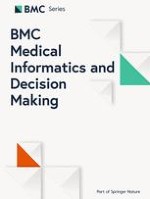Published in:

Open Access
01-12-2019 | Glucose Tolerance Test | Research
Statistical and spectral analysis of ECG signal towards achieving non-invasive blood glucose monitoring
Authors:
Igbe Tobore, Jingzhen Li, Abhishek Kandwal, Liu Yuhang, Zedong Nie, Lei Wang
Published in:
BMC Medical Informatics and Decision Making
|
Special Issue 6/2019
Login to get access
Abstract
Background
Globally, the cases of diabetes mellitus (diabetes) have increased in the past three decades, and it is recorded as one of the leading cause of death. This epidemic is a metabolic condition where the body cannot regulate blood glucose, thereby leading to abnormally high blood sugar. Genetic condition plays a significant role to determine a person susceptibility to the condition, a sedentary lifestyle and an unhealthy diet are behaviour that supports the current global epidemic. The complication that arises from diabetes includes loss of vision, peripheral neuropathy, cardiovascular complications and so on. Victims of this condition require constant monitoring of blood glucose which is done by the pricking of the finger. This procedure is painful, inconvenient and can lead to disease infection. Therefore, it is important to find a way to measure blood glucose non-invasively to minimize or eliminate the disadvantages encountered with the usual monitoring of blood glucose.
Method
In this paper, we performed two experiments on 16 participants while electrocardiogram (ECG) data was continuously captured. In the first experiment, participants are required to consume 75 g of anhydrous glucose solution (oral glucose tolerance test) and the second experiment, no glucose solution was taken. We explored statistical and spectral analysis on HRV, HR, R-H, P-H, PRQ, QRS, QT, QTC and ST segments derived from ECG signal to investigate which segments should be considered for the possibility of achieving non-invasive blood glucose monitoring. In the statistical analysis, we examined the pattern of the data with the boxplot technique to reveal the change in the statistical properties of the data. Power spectral density estimation was adopted for the spectral analysis to show the frequency distribution of the data.
Results
HRV segment obtained a statistical score of 81% for decreasing pattern and HR segment have the same statistical score for increasing pattern among the participants in the first quartile, median and mean properties. While ST segment has a statistical score of 81% for decreasing pattern in the third quartile, QT segment has 81% for increasing pattern for the median. From a total change score of 6, ST, QT, PRQ, P-H, HR and HRV obtained 4, 5, 4, 5 and 6 respectively. For spectral analysis, HRV and HR segment scored 81 and 75% respectively. ST, QT, PRQ have 75, 62 and 68% respectively.
Conclusions
The results obtained demonstrate that HR, HRV, PRQ, QT and ST segments under a normal, healthy condition are affected by glucose and should be considered for modelling a system to achieve the possibility of non-invasive blood glucose measurement with ECG.





